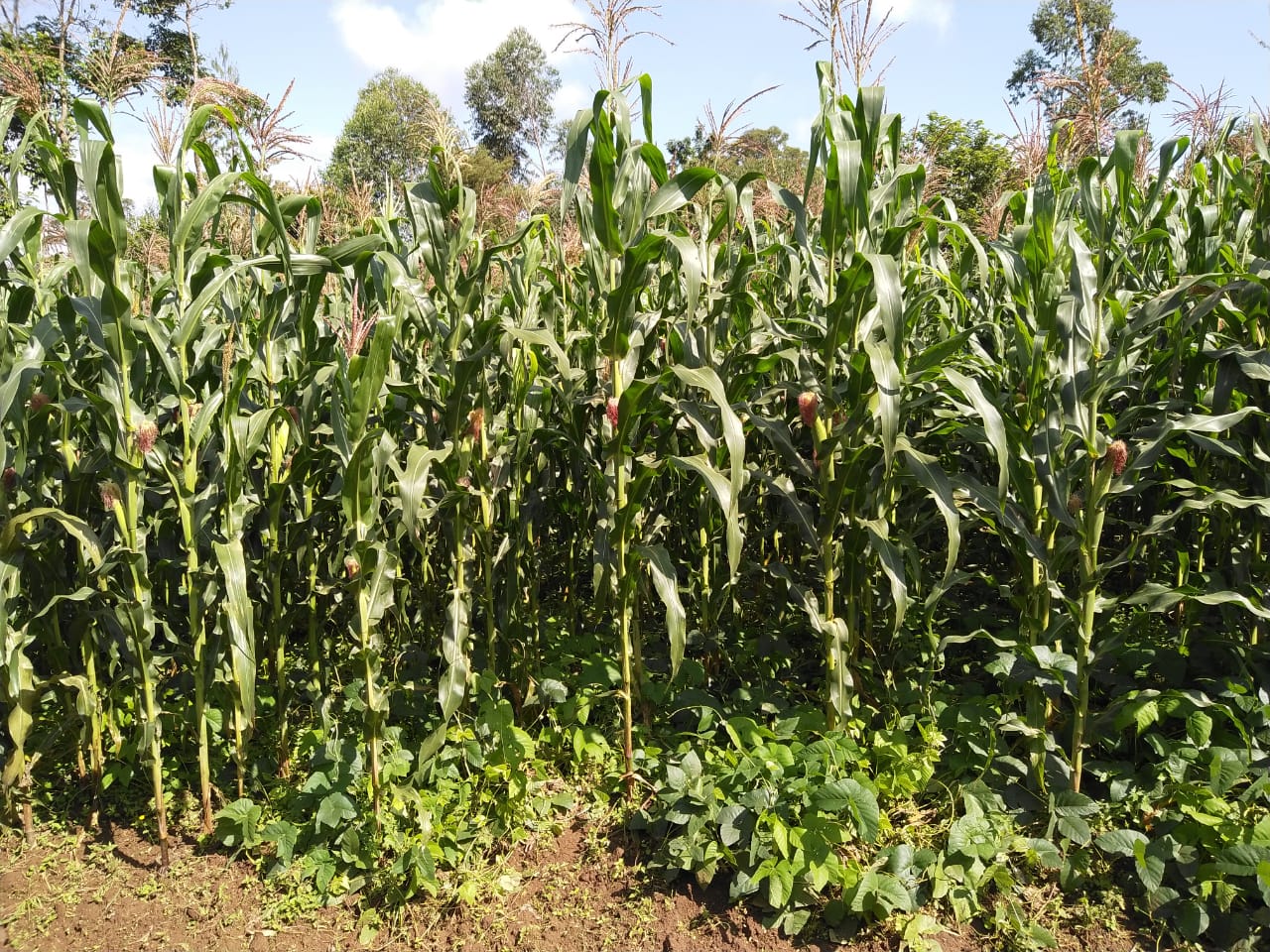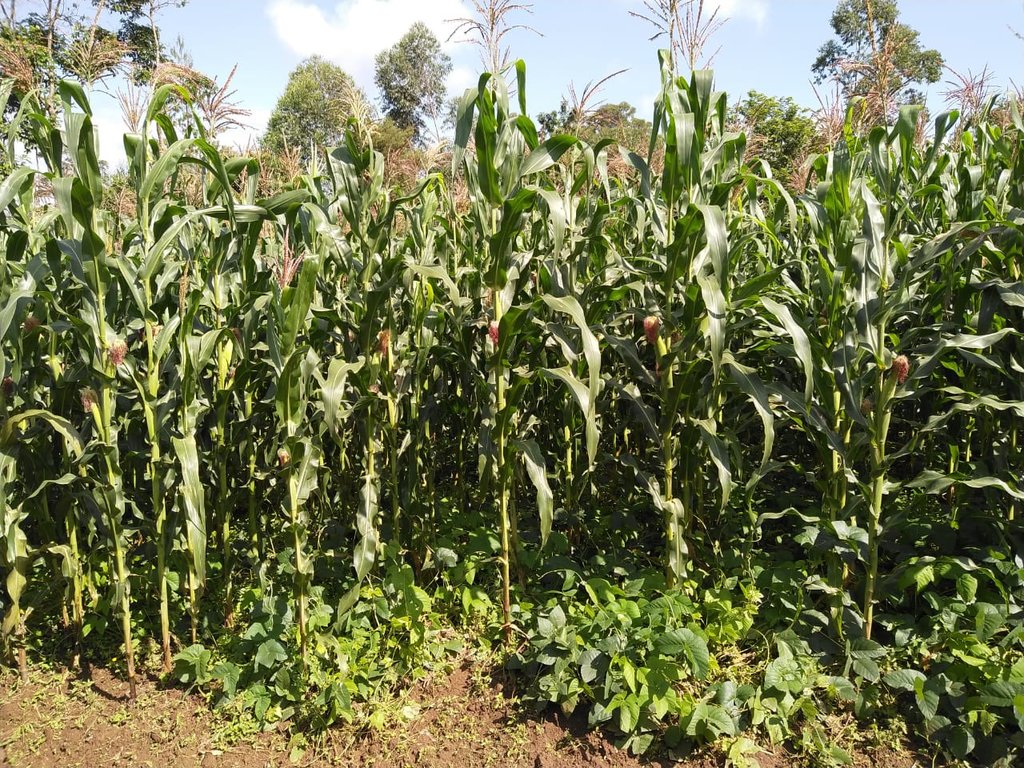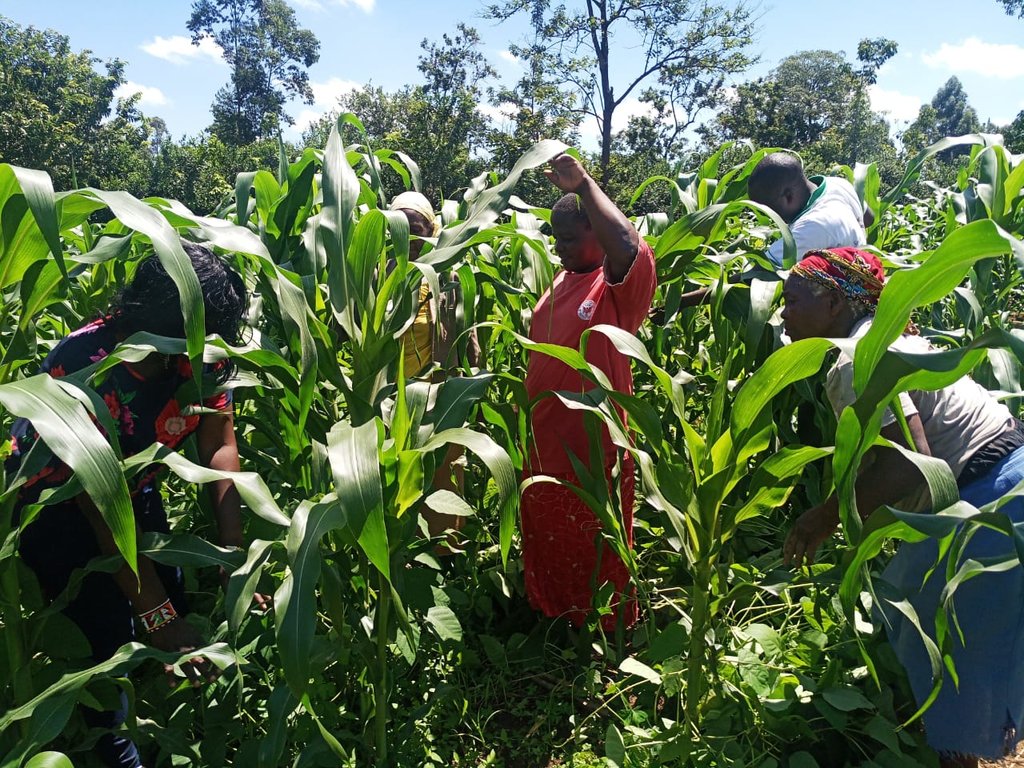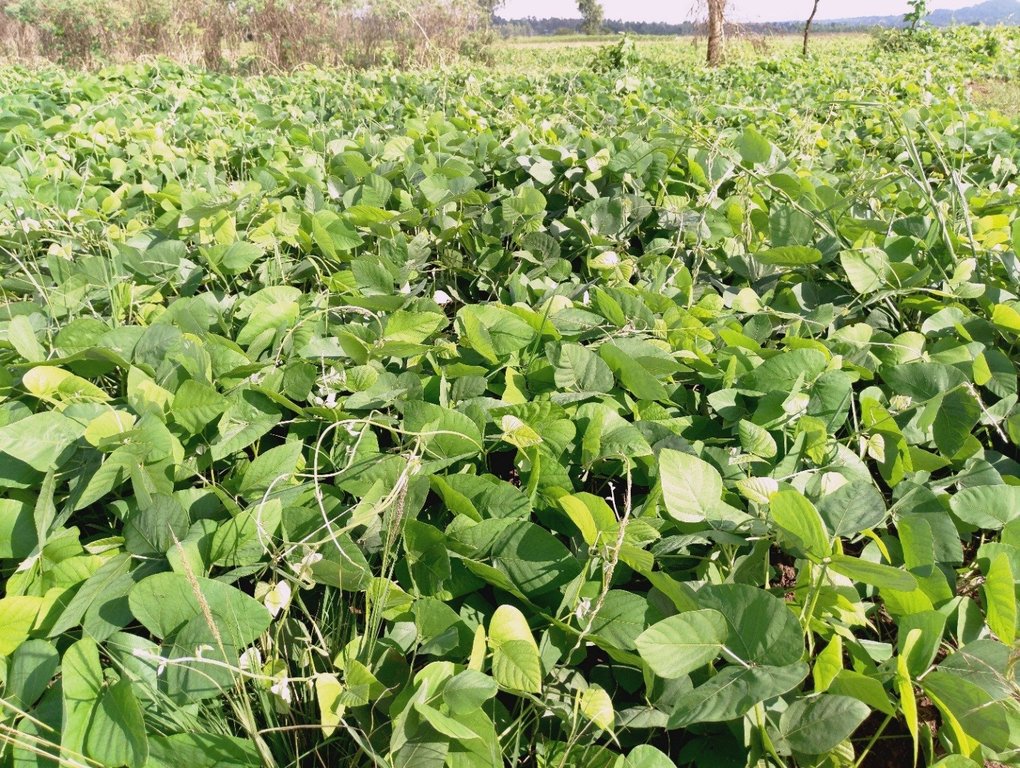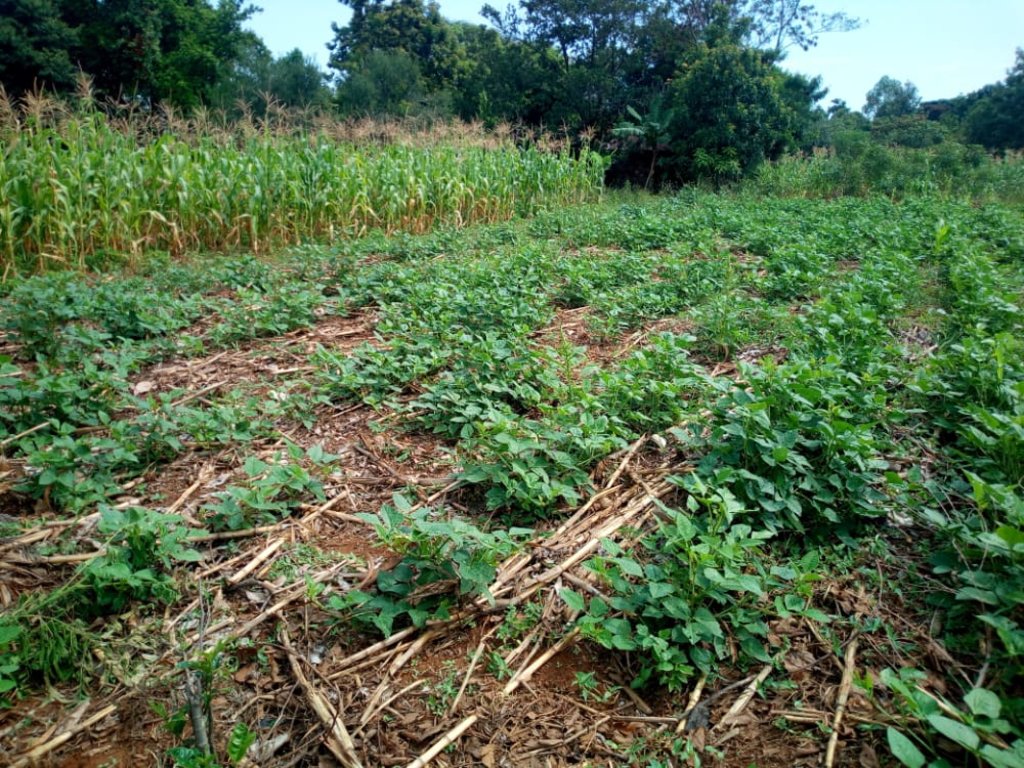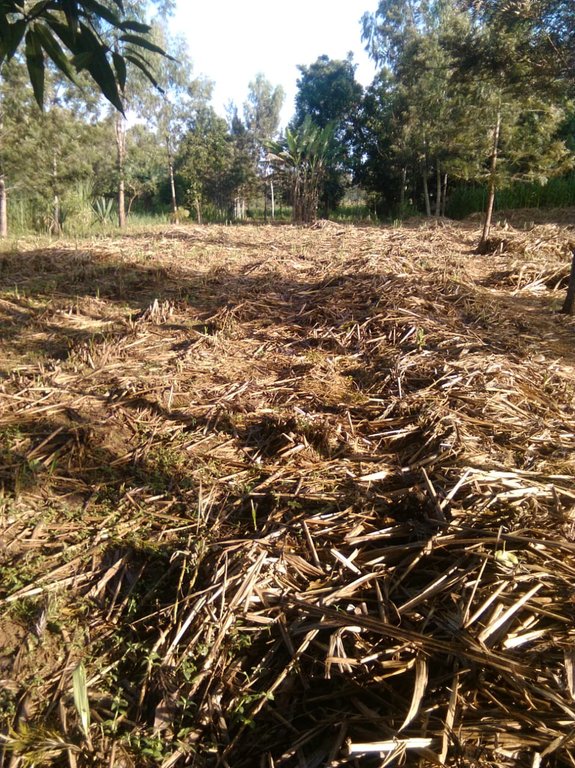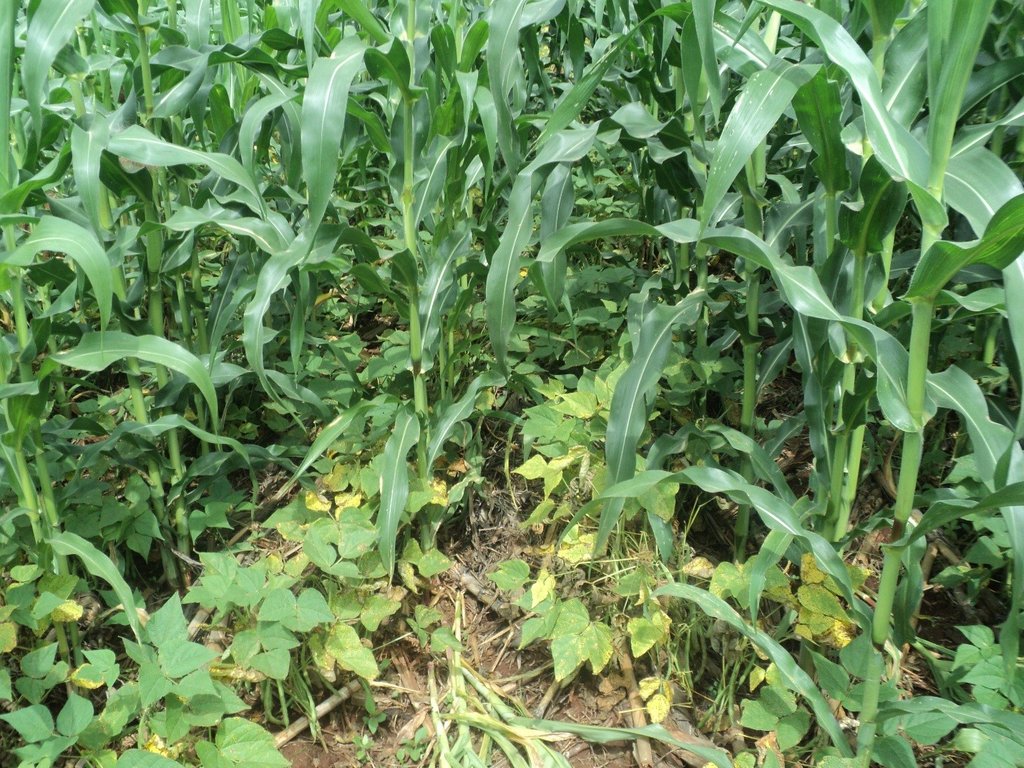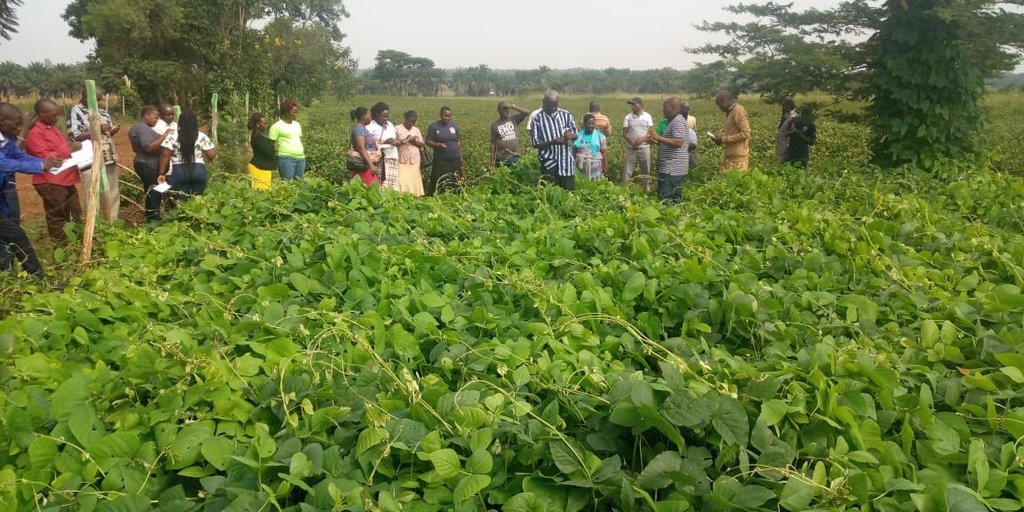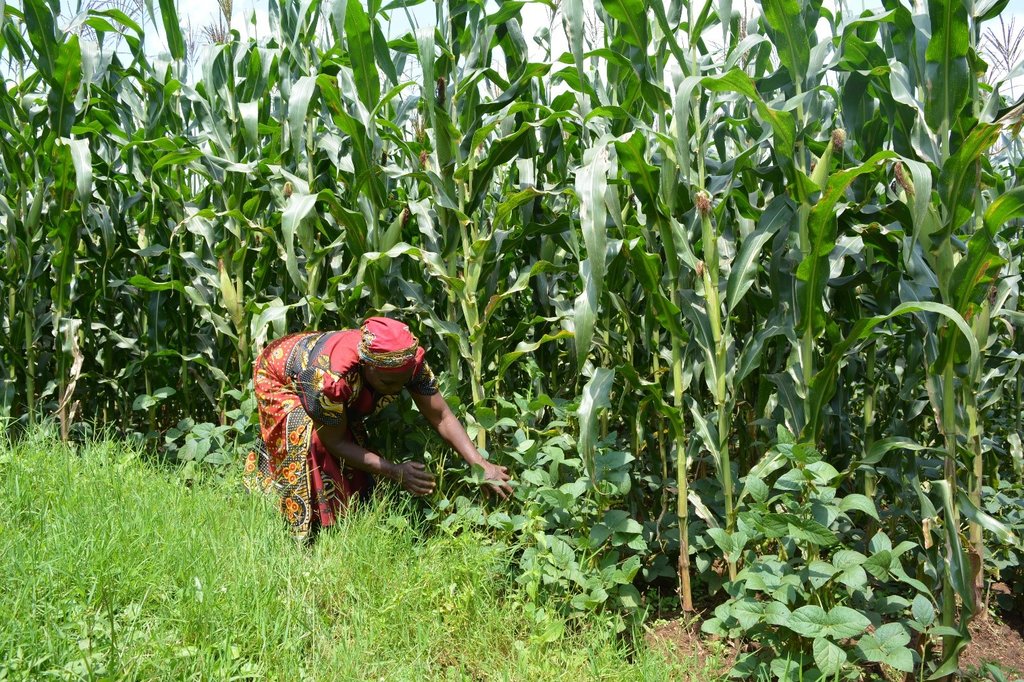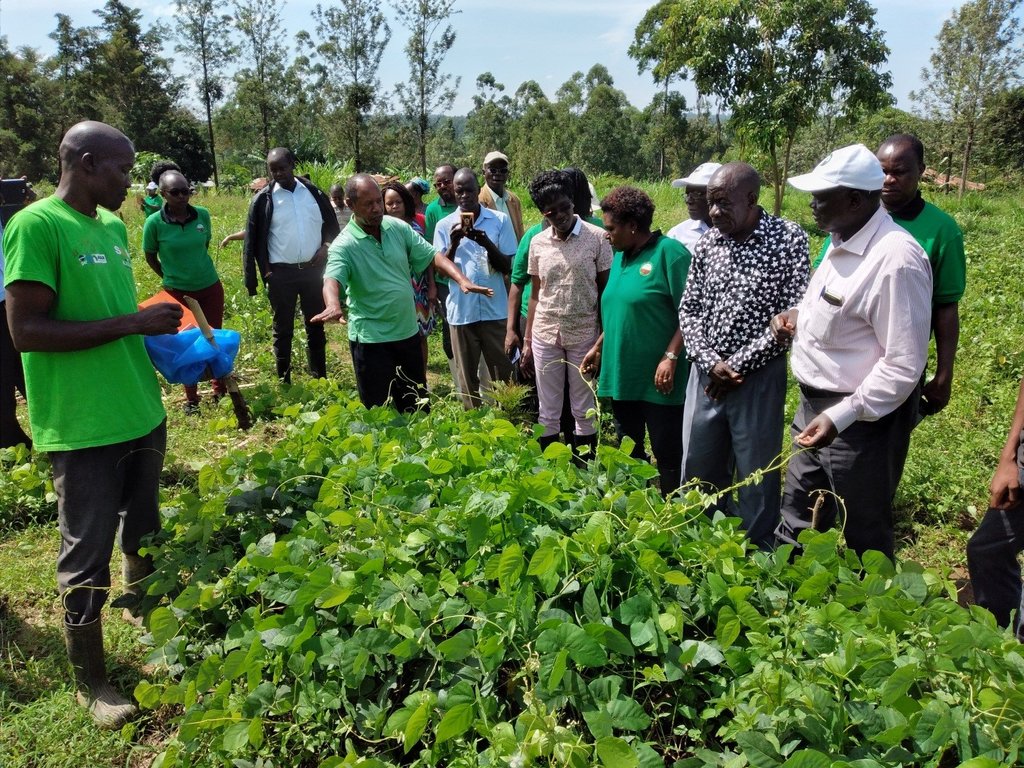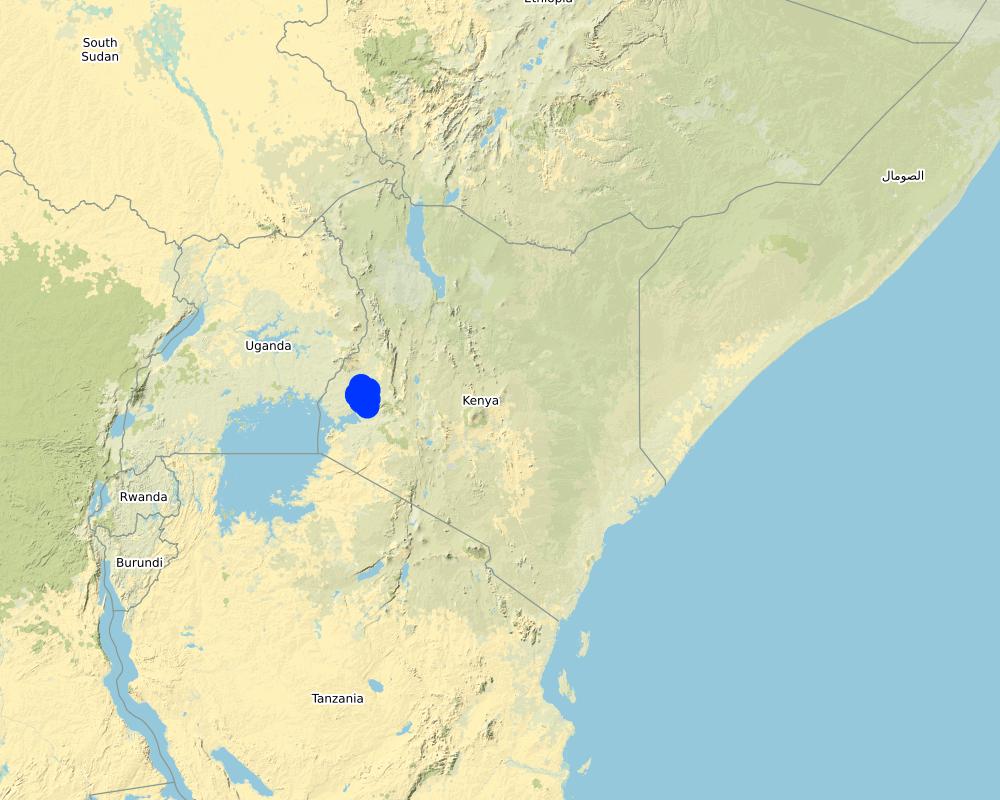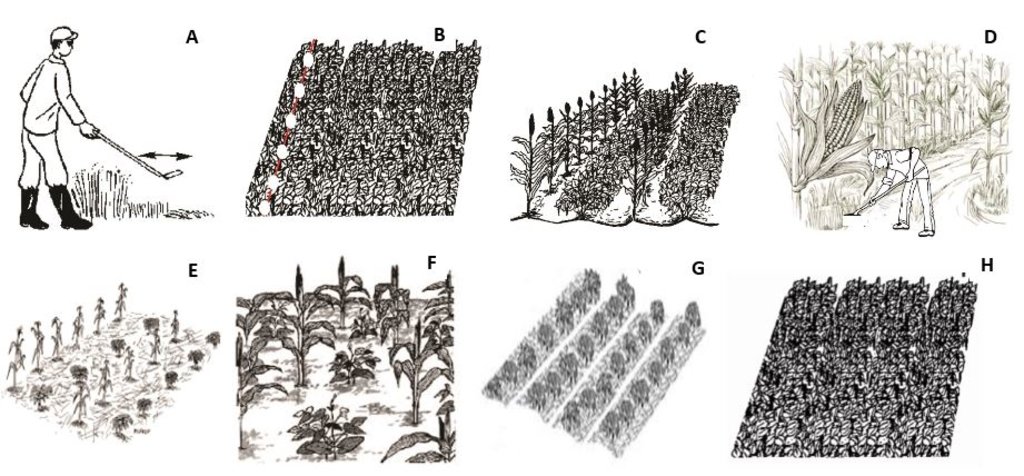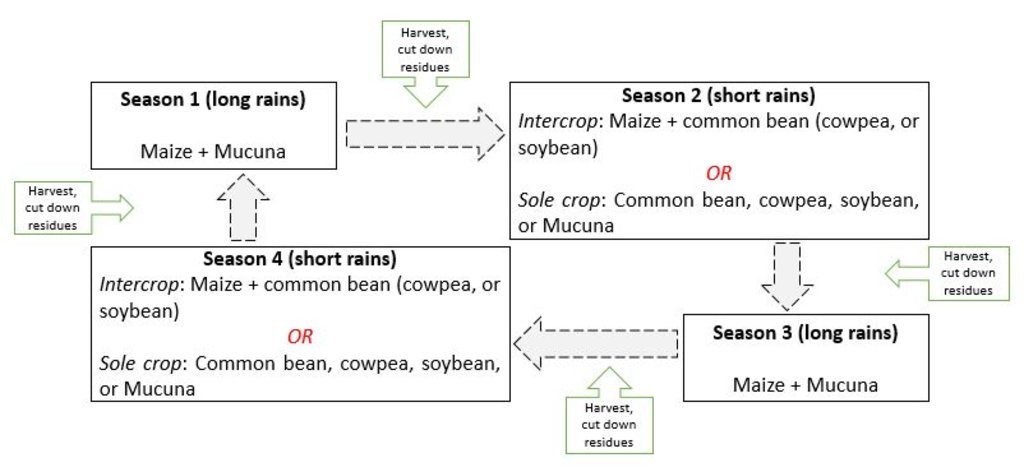Conservation agriculture for maize-legume systems with velvet bean as a dense cover crop [ເຄັນຢາ]
- ການສ້າງ:
- ປັບປູງ:
- ຜູ້ສັງລວມຂໍ້ມູນ: Kennedy Were
- ບັນນາທິການ: –
- ຜູ້ທົບທວນຄືນ: Rima Mekdaschi Studer, Tatenda Lemann
Kilimo hifadhi
technologies_5775 - ເຄັນຢາ
ເບິ່ງພາກສ່ວນ
ຂະຫຍາຍທັງໝົດ ຍຸບທັງໝົດ1. ຂໍ້ມູນທົ່ວໄປ
1.2 ຂໍ້ມູນ ການຕິດຕໍ່ພົວພັນ ຂອງບຸກຄົນທີ່ສໍາຄັນ ແລະ ສະຖາບັນ ທີ່ມີສ່ວນຮ່ວມ ໃນການປະເມີນເອກກະສານ ເຕັກໂນໂລຢີ
ຜຸ້ຊ່ຽວຊານ ດ້ານການຄຸ້ມຄອງ ທີ່ດິນແບບຍືນຍົງ:
ຜຸ້ຊ່ຽວຊານ ດ້ານການຄຸ້ມຄອງ ທີ່ດິນແບບຍືນຍົງ:
ຜຸ້ຊ່ຽວຊານ ດ້ານການຄຸ້ມຄອງ ທີ່ດິນແບບຍືນຍົງ:
ຜຸ້ຊ່ຽວຊານ ດ້ານການຄຸ້ມຄອງ ທີ່ດິນແບບຍືນຍົງ:
ຊື່ໂຄງການ ທີ່ອໍານວຍຄວາມສະດວກ ໃນການສ້າງເອກກະສານ/ປະເມີນ ເຕັກໂນໂລຢີ (ຖ້າກ່ຽວຂ້ອງ)
GEF-UNEP-AGRA-KALRO SLM Projectຊື່ໂຄງການ ທີ່ອໍານວຍຄວາມສະດວກ ໃນການສ້າງເອກກະສານ/ປະເມີນ ເຕັກໂນໂລຢີ (ຖ້າກ່ຽວຂ້ອງ)
Carbon Benefits Project (CBP)ຊື່ສະຖາບັນ (ຫຼາຍສະຖາບັນ) ທີ່ອໍານວຍຄວາມສະດວກ ໃນການສ້າງເອກກະສານ / ປະເມີນ ເຕັກໂນໂລຢີ (ຖ້າກ່ຽວຂ້ອງ)
Kenya Agricultural and Livestock Research Organization (KALRO) - ເຄັນຢາ1.3 ເງື່ອນໄຂ ກ່ຽວກັບ ການນໍາໃຊ້ຂໍ້ມູນເອກະສານ ທີ່ສ້າງຂື້ນ ໂດຍຜ່ານ ອົງການພາບລວມຂອງໂລກ ທາງດ້ານແນວທາງ ແລະ ເຕັກໂນໂລຢີ ຂອງການອານຸລັກ ທໍາມະຊາດ (WOCAT)
ຜູ້ປ້ອນຂໍ້ມູນ ແລະ ບຸກຄົນສຳຄັນ ທີ່ໃຫ້ຂໍ້ມູນ (ຫຼາຍ) ຍິນຍອມ ຕາມເງື່ອນໄຂ ໃນການນຳໃຊ້ຂໍ້ມູນ ເພື່ອສ້າງເປັນເອກກະສານຂອງ WOCAT:
ແມ່ນ
1.4 ແຈ້ງການວ່າ ດ້ວຍຄວາມຍືນຍົງຂອງ ເຕັກໂນໂລຢີ
ການນໍາໃຊ້ ເຕັກໂນໂລຢີ ດັ່ງກ່າວໄດ້ອະທິບາຍ ເຖິງບັນຫາ ກ່ຽວກັບ ການເຊື່ອມໂຊມຂອງດິນບໍ? ຖ້າບໍ່ດັ່ງນັ້ນ ມັນບໍ່ສາມາດ ຢັ້ງຢືນໄດ້ວ່າ ເປັນເຕັກໂນໂລຊີ ໃນການຄຸ້ມຄອງ ທີ່ດິນແບບຍືນຍົງ? :
ບໍ່ແມ່ນ
2. ການອະທິບາຍ ເຕັກໂນໂລຢີ ຂອງການຄຸ້ມຄອງ ທີ່ດິນແບບຍືນຍົງ
2.1 ຄໍາອະທິບາຍສັ້ນຂອງ ເຕັກໂນໂລຢີ
ການກຳໜົດຄວາມໝາຍ ຂອງເຕັກໂນໂລຢີ:
Conservation agriculture for maize-legume systems with velvet bean (Mucuna pruriens) as a dense cover crop is being promoted in western Kenya to address the challenges of land degradation, low crop yields, low incomes, high production costs and climate change.
2.2 ການອະທິບາຍ ລາຍລະອຽດ ຂອງເຕັກໂນໂລຢີ
ການພັນລະນາ:
Agriculture in western Kenya suffers from low productivity due to the degraded landscape. The soils are predominantly acidic and low in fertility, with the yields of food staples, such as maize and common bean averaging 1 ton/ ha and 5 tons/ ha, respectively. Consequently, the smallholder farmers have encroached into the adjacent Kakamega and Nandi forests in their quest for supplementary agro-ecosystem services and farm incomes. Degradation of the agro-resource base is underpinned by unsustainable practices carried out under conventional farming; for example, continuous cultivation with low nutrient inputs, mono-cropping, removal of crop residues and full tillage. Some of these practices enhance climate change by intensifying the emissions of greenhouse gases, such as carbon dioxide (CO2) into the atmosphere. Therefore, widespread adoption of conservation agriculture (CA) technology is being promoted to reduce the adverse impacts of conventional farming and enhance sustainable land management, environmental protection, and climate change mitigation and adaptation in 10 micro-catchments located within a 5-km radius from the edge of Kakamega and Nandi forests. The CA technology is characterized by the principles of minimum mechanical soil disturbance, maintenance of at least 30 percent permanent organic soil cover, diversified cropping through intercropping and crop rotations, and weed control. These principles have been adapted to the local conditions and needs.
The establishment of CA technology begins with land preparation. That is, the existing weeds and previous crop residues in the field are either slashed, or controlled through the application of appropriate herbicides. All the residues are retained on soil surface as opposed to burning, or removal in the conventional system. Land preparation is followed by planting, where the jab planter is used for precise placement of seeds and fertilizers in un-ploughed field, or within the established planting hills and rip lines to minimize soil tillage. This contrasts with conventional farming practice where a plough, or a hand hoe is used to till the entire field and establish the planting holes for placing seeds and fertilizers. A combination of cereal (maize – Zea mays L.) and legumes (common bean – Phaseolus vulgaris L., soybean - Glycine max, velvet bean – Mucuna pruriens and cowpea – Vigna unguiculata) are either intercropped, or rotated in the field each season to optimize the use of the available soil resources, including water, nutrients, and micro-organisms. The main cereal-legume association involves the establishment of Mucuna pruriens under maize as a dense cover crop. In this cropping system, Mucuna pruriens seeds are sown within a spacing of 1 m × 0.5 m where they grow and spread to completely cover the soil surface. As the cover crop grows, the leaves fall and decompose on the ground, enriching the soil’s nutrients, organic matter and fertility. The maize - Mucuna pruriens mix is rotated with either sole common bean, soybean and cowpea crop, or an intercrop of maize with any of the legumes. Weeding is carried out using either selective herbicides, or weed scrapers. When designing the intercropping and rotation plans, crop families (N-fixing vs. non-fixing), root depths (shallow vs. deep roots), and susceptibility to diseases, pests and weeds are all considered.
Generally, CA technologies have multiple benefits for farmers and the environment. In the context of the Kakamega-Nandi forest landscape, the CA plots with Mucuna pruriens as a dense cover crop have shown improved soil organic matter, soil structure and nutrient status. It is expected that this will reduce the use of fertilizers over time. Most farmers have also reported that reduced tillage and direct placement of inputs (seeds and fertilizers) save them time, money, fuel, labour and inputs. Aside from saving resources, reduced tillage will ultimately enhance soil living organisms and mitigate atmospheric CO2 emissions through the decrease in fuel consumption and soil disturbance. Moreover, farmers have observed that the maize established with Mucuna pruriens as a cover crop remains green and healthy for long during mid-season dry spells compared to those under mono-culture, or light mulch. This implies that the CA technology also increases water infiltration and soil water content; thus, acting as insurance against drought. The increase in water infiltration and soil moisture occurs because the dense Mucuna pruriens cover crop not only regulates the soil surface temperatures and evaporation, but also reduces surface runoff and exposure to wind erosion. In addition, farmers have witnessed the suppression of weeds, such as Striga hermonthica (witchweed) in plots under dense cover crop and diversified cropping. Besides, diversified cropping through rotations has reduced the incidences of insect pests and diseases, as well as the risk of crop failure during extreme weather conditions and pest infestations. Specifically, farmers have noticed that the CA plots under maize - Mucuna pruriens intercrop are less affected by the fall armyworm (Spodoptera frugiperda) compared to those under mono-culture. They have also noted that, in seasons of excessive rainfall, the maize intercropped with the common bean is usually harvested even when the common bean fails. Most importantly, these CA benefits have boosted maize yields by over 50 percent, meaning more food and income, and fewer forest encroachments.
Proper adoption of the CA technology by land users within the Kakamega-Nandi forest landscape is being hampered by several factors. Firstly, crop residues are inadequate due to competing uses, such as animal feed and fuel. At times, livestock is even allowed to graze on the stubble field, contravening the CA principles. Besides, some farmers have not fully embraced crop diversification and still grow maize throughout the seasons without rotation with other drought-tolerant cereals, such as sorghum and millet. Conventional ploughing is also quite entrenched. Further, some farmers still do not prefer Mucuna pruriens as a cover crop because of insufficient knowledge on the utilization of its inedible yields. Lastly, some farmers are finding it hard to access CA inputs and tools, such as the jab planters, weed scrapers, herbicides and seeds of Mucuna pruriens owing to either high prices, or shortages.
2.3 ຮູບພາບຂອງເຕັກໂນໂລຢີ
2.4 ວິດີໂອ ເຕັກໂນໂລຢີ
2.5 ປະເທດ / ເຂດ / ສະຖານທີ່ບ່ອນທີ່ ເຕັກໂນໂລຢີ ໄດ້ຮັບການນໍາໃຊ້ ແລະ ທີ່ຖືກປົກຄຸມດ້ວຍການປະເມີນຜົນ
ປະເທດ:
ເຄັນຢາ
ພາກພື້ນ / ລັດ / ແຂວງ:
Western region
ຂໍ້ມູນເພີ່ມເຕີມຂອງສະຖານທີ່:
Kakamega-Nandi forest landscape
ໃຫ້ລະບຸ ການແຜ່ຂະຫຍາຍ ເຕັກໂນໂລຢີ:
- ນໍາໃຊ້ໃນຈຸດສະເພາະ / ແນໃສ່ນໍາໃຊ້ໃນພື້ນທີ່ຂະໜາດນ້ອຍ
ສ່ວນຫຼາຍສະຖານທີ່ຕັ້ງຂອງເຕັກໂນໂລຢີ ແມ່ນ ຢູ່ໃນເຂດພື້ນທີ່ສະຫງວນບໍ?
ບໍ່ແມ່ນ
Map
×2.6 ວັນທີໃນການຈັດຕັ້ງປະຕິບັດ
ໃຫ້ລະບຸປີ ໃນການຈັດຕັ້ງປະຕິບັດ:
2019
2.7 ການນໍາສະເໜີ ເຕັກໂນໂລຢີ
ໃຫ້ລະບຸ ເຕັກໂນໂລຢີ ໄດ້ຖືກຈັດຕັ້ງປະຕິບັດຄືແນວໃດ?
- ໃນໄລຍະການທົດລອງ / ການຄົ້ນຄວ້າ
- ໂດຍຜ່ານໂຄງການ / ການຊ່ວຍເຫຼືອຈາກພາຍນອກ
ຄວາມຄິດເຫັນ (ປະເພດ ໂຄງການ ແລະ ອື່ນໆ):
Projects and research focusing mainly on advancing land degradation neutrality and agricultural productivity in the area
3. ການໃຈ້ແຍກ ເຕັກໂນໂລຢີ ໃນການຄຸ້ມຄອງ ດິນແບບຍືນຍົງ
3.1 ຈຸດປະສົງຫຼັກ (ຫຼາຍ) ຂອງເຕັກໂນໂລຢີ
- ປັບປຸງ ການຜະລິດ
- ຫຼຸດຜ່ອນ, ປ້ອງກັນ, ຟື້ນຟູ ການເຊື່ອມໂຊມຂອງດິນ
- ປົກປັກຮັກສາ / ການປັບປຸງຊີວະນາໆພັນ
- ຫຼຸດຜ່ອນຜົນກະທົບ ຈາກການປ່ຽນແປງດິນຟ້າອາກາດ
- ສ້າງຜົນກະທົບ ທາງເສດຖະກິດ ທີ່ເປັນປະໂຫຍດ
3.2 ປະເພດການນໍາໃຊ້ທີ່ດິນ ໃນປະຈຸບັນ() ທີ່ເຕັກໂນໂລຢີ ໄດ້ຖືກນໍາໃຊ້
ການນຳໃຊ້ທີ່ດິນ ປະສົມພາຍໃນພື້ນທີ່ດຽວກັນ:
ແມ່ນ
ລະບຸການນຳໃຊ້ທີ່ດິນແບບປະສົມ (ຜົນລະປູກ / ທົ່ງຫຍ້າລ້ຽງສັດ / ຕົ້ນໄມ້):
- ກະສິກໍາແບບປະສົມປະສານ (ລວມທັງ ການລ້ຽງສັດ-ປຸກຝັງ)

ດິນທີ່ປູກພືດ
- ການປູກພືດປະຈໍາປີ
ການປູກພືດປະຈຳປີ - ລະບຸປະເພດພືດ:
- ທັນຍາພືດ-ສາລີ
- ພືດຕະກູນຖົ່ວ ແລະ ຖົ່ວປະເພດອື່ນໆ
- ພືດຕະກູນຖົ່ວ ແລະ ຖົ່ວແປກ
- ພືດຕະກູນຖົ່ວ ແລະ ຖົ່ວເຫຼືອງ
ລະບົບການປູກພືດປະຈຳປີ:
ສາລີ/ພືດປະເພດເຂົ້າ/ພືດປະເພດເມັດ ປະສົມປະສານ ກັບ ຖົ່ວ
ຈໍານວນ ລະດູການ ປູກໃນປີໜຶ່ງ:
- 2
ລະບຸ ຊະນິດ:
Long rain season (March to May) and short rain season (October to December)
ມີການເຝືກປູກພືດແບບສັບຫວ່າງບໍ່?
ແມ່ນ
ຖ້າມີ, ໃຫ້ລະບຸວ່າປູກພືດຊະນິດໃດທີ່ປູກສັບຫວ່າງ:
Maize and legumes (i.e., common bean, soybean and velvet bean – Mucuna pruriens)
ມີການເຝືກປູກພືດແບບໝູນວຽນບໍ່?
ແມ່ນ
ຖ້າແມ່ນ, ໃຫ້ລະບຸແຈ້ງ:
Maize and legumes (i.e., common bean, soybean and velvet bean – Mucuna pruriens)

ທົ່ງຫຍ້າລ້ຽງສັດ
ທົ່ງຫຍ້າລ້ຽງສັດແບບສຸມ / ການຜະລິດອາຫານສັດ:
- ຕັດຫຍ້າ ແລະ ຂົນຫຍ້າ / ບໍ່ມີທົ່ງຫຍ້າທໍາມະຊາດ
- ປັບປຸງ ທົ່ງຫຍ້າ
ປະເພດສັດ:
- cattle - dairy and beef (e.g. zebu)
ແມ່ນການເຝືກຄຸ້ມຄອງ ການປູກພືດປະສົມປະສານ ກັບການລ້ຽງສັດບໍ່?
ແມ່ນ
ຖ້າແມ່ນ, ໃຫ້ລະບຸແຈ້ງ:
Manure is used for fertilization and crop residues are used as cattle feed
ຜະລິດຕະພັນ ແລະ ການບໍລິການ:
- manure as fertilizer/ energy production
- ຊີ້ນ
- ນ້ຳນົມ
- ຜິວໜັງ/ໜັງ
- ການຂົນສົ່ງ/ ການລາກ
3.3 ການນຳໃຊ້ທີ່ດິນ ມີການປ່ຽນແປງຍ້ອນການຈັດຕັ້ງທົດລອງເຕັກໂນໂລຢີ ແມ່ນບໍ່?
ການນຳໃຊ້ທີ່ດິນ ມີການປ່ຽນແປງຍ້ອນການຈັດຕັ້ງທົດລອງເຕັກໂນໂລຢີ ແມ່ນບໍ່?
- ແມ່ນ (ກະລຸນາຕື່ມໃສ່ ຄຳຖາມຂ້າງລຸ່ມນີ້ກ່ຽວກັບການນຳໃຊ້ທີ່ດິນ ກ່ອນການທົດລອງເຕັກໂນໂລຢີ)
ການນຳໃຊ້ທີ່ດິນ ປະສົມພາຍໃນພື້ນທີ່ດຽວກັນ:
ແມ່ນ
ລະບຸການນຳໃຊ້ທີ່ດິນແບບປະສົມ (ຜົນລະປູກ / ທົ່ງຫຍ້າລ້ຽງສັດ / ຕົ້ນໄມ້):
- ກະສິກໍາແບບປະສົມປະສານ (ລວມທັງ ການລ້ຽງສັດ-ປຸກຝັງ)

ດິນທີ່ປູກພືດ
- ການປູກພືດປະຈໍາປີ
ການປູກພືດປະຈຳປີ - ລະບຸປະເພດພືດ:
- ທັນຍາພືດ-ສາລີ
ລະບົບການປູກພືດປະຈຳປີ:
ສືບຕໍ່ປູກ ສາລີ/ພືດປະເພດຖົ່ວ/ພືດປະເພດເມັດ
ມີການເຝືກປູກພືດແບບສັບຫວ່າງບໍ່?
ບໍ່ແມ່ນ
ມີການເຝືກປູກພືດແບບໝູນວຽນບໍ່?
ບໍ່ແມ່ນ

ທົ່ງຫຍ້າລ້ຽງສັດ
ທົ່ງຫຍ້າລ້ຽງສັດແບບສຸມ / ການຜະລິດອາຫານສັດ:
- ຕັດຫຍ້າ ແລະ ຂົນຫຍ້າ / ບໍ່ມີທົ່ງຫຍ້າທໍາມະຊາດ
ປະເພດສັດ:
- cattle - dairy and beef (e.g. zebu)
ແມ່ນການເຝືກຄຸ້ມຄອງ ການປູກພືດປະສົມປະສານ ກັບການລ້ຽງສັດບໍ່?
ແມ່ນ
ຖ້າແມ່ນ, ໃຫ້ລະບຸແຈ້ງ:
Manure is used for fertilization and crop residues are used as cattle feed
ຜະລິດຕະພັນ ແລະ ການບໍລິການ:
- manure as fertilizer/ energy production
- ຊີ້ນ
- ນ້ຳນົມ
- ຜິວໜັງ/ໜັງ
- ການຂົນສົ່ງ/ ການລາກ
3.4 ການສະໜອງນ້ຳ
ການສະໜອງນໍ້າ ໃນພື້ນທີ່ ທີ່ໄດ້ນໍາໃຊ້ ເຕັກໂນໂລຢີ:
- ນໍ້າຝົນ
3.5 ການນໍາໃຊ້ເຕັກໂນໂລຢີ ທີ່ຢູ່ໃນກຸ່ມການຄຸ້ມຄອງ ທີ່ດິນແບບຍືນຍົງ
- ການປັບປຸງດິນ / ພືດຄຸມດິນ
- ການຫຼຸດຜ່ອນ ກິດຈະກໍາ ທີ່ລົບກວນດິນ
- ການຈັດການອຸດົມສົມບູນ ຂອງດິນປະສົມປະສານ
3.6 ມາດຕະການ ການຄຸ້ມຄອງ ທີ່ດິນແບບຍືນຍົງ ປະກອບດ້ວຍ ເຕັກໂນໂລຢີ

ມາດຕະການ ທາງການກະສິກໍາ
- A1: ພືດ / ການປົກຫຸ້ມຂອງດິນ
- A2: ອິນຊີວັດຖຸ ຫຼື ຄວາມອຸດົມສົມບູນໃນດິນ
- A3: ການບໍາລຸງຮັກສາຊັ້ນໜ້າດິນ
- A6: ການຈັດການສິ່ງເສດເຫຼືອ
A3: ລະບົບການໄຖແຕກຕ່າງກັນ:
A 3.2: Reduced tillage (> 30% soil cover)
A6: ລະບຸການຈັດການສິ່ງເສດເຫຼືອ:
A 6.4: ເກັບຮັກສາໄວ້
3.7 ປະເພດດິນເຊື່ອມໂຊມ ຫຼັກທີ່ໄດ້ນໍາໃຊ້ ເຕັກໂນໂລຢີ

ດິນເຊາະເຈື່ອນ ໂດຍນໍ້າ
- Wt: ການສູນເສຍຊັ້ນໜ້າດິນ / ການເຊາະເຈື່ອນຜິວໜ້າດິນ

ດິນເຊາະເຈື່ອນ ໂດຍລົມ
- ການສູນເສຍຊັ້ນໜ້າດິນ

ການເຊື່ອມໂຊມ ຂອງດິນ ທາງເຄມີ
- Cn: ຄວາມອຸດົມສົມບູນ ລົດໜ້ອຍຖອຍລົງ ແລະ ສານອິນຊີວັດຖຸລົດລົງ (ບໍ່ແມ່ນສາເຫດມາຈາກການເຊາະເຈື່ອນ)

ການເຊື່ອມໂຊມ ຂອງດິນ ທາງກາຍະພາບ
- Pc: ການອັດແໜ້ນ

ການເຊື່ອມໂຊມ ທາງຊີວະພາບ
- Bl: ການສູນເສຍ ຈຸລິນຊີໃນດິນ

ການເຊື່ອມໂຊມ ຂອງນໍ້າ
- Ha: ສະພາບແຫ້ງແລ້ງ
3.8 ການປ້ອງກັນ, ການຫຼຸດຜ່ອນ, ຫຼືການຟື້ນຟູຂອງການເຊື່ອມໂຊມຂອງດິນ
ໃຫ້ລະບຸ ເປົ້າໝາຍ ເຕັກໂນໂລຢີ ທີ່ພົວພັນ ກັບຄວາມເຊື່ອມໂຊມຂອງດິນ:
- ຫຼຸດຜ່ອນການເຊື່ອມໂຊມຂອງດິນ
4. ຂໍ້ກໍາໜົດ, ກິດຈະກໍາການປະຕິບັດ, ວັດຖຸດິບ, ແລະຄ່າໃຊ້ຈ່າຍ
4.1 ເຕັກນິກ ໃນການແຕ້ມແຜນວາດ ເຕັກໂນໂລຢີ
ຄຸນລັກສະນະ ຂອງເຕັກນິກ (ທີ່ກ່ຽວຂ້ອງ ກັບການແຕ້ມແຜນວາດ ທາງດ້ານເຕັກນີກ):
The first technical drawing shows a typical farm under CA with various principles:
A - Clearance of weeds and previous crop residues through slashing in preparation for planting in season 1 (long rains). The residues are retained on the plot.
B - In a plot under total soil cover with Mucuna pruriens, maize seed and fertilizer are placed at the precise planting hills, denoted by the white circles along the red line, using a jab planter to minimize soil tillage.
C - Maize crop establishes under the dense cover of Mucuna pruriens.
D - Weeding of the maize crop is done using a weed scraper.
E & F - In season 2 (short rains), after harvesting maize in the previous maize – Mucuna cropping system and cutting down the residues, either a row intercropping system with alternate rows of maize and soybean (E), or maize and common bean (F) under maize straw mulch is established.
G & H - Alternatively, in season 2 (short rains), either sole common bean (cowpea, or soybean) production under maize straw mulch (G), or total soil cover with Mucuna pruriens (H) is established in the plot.
ຜູ້ຂຽນ:
Sam Koile, Kennedy Were & George Ayaga
ວັນທີ:
31/05/2020
ຄຸນລັກສະນະ ຂອງເຕັກນິກ (ທີ່ກ່ຽວຂ້ອງ ກັບການແຕ້ມແຜນວາດ ທາງດ້ານເຕັກນີກ):
The second technical drawing is an illustration of a four season (2-year) rotation of maize, legumes and cover crop
ຜູ້ຂຽນ:
Kennedy Were, Sam Koile & George Ayaga
ວັນທີ:
15/07/2020
4.2 ຂໍ້ມູນທົ່ວໄປກ່ຽວກັບການຄິດໄລ່ປັດໃຈຂາເຂົ້າໃນການຜະລິດ ແລະ ມູນຄ່າອື່ນໆ
ລະບຸ ວິທີການ ຄຳໃຊ້ຈ່າຍ ແລະ ປັດໄຈນໍາເຂົ້າ ທີ່ໄດ້ຄິດໄລ່:
- ຕໍ່ພື້ນທີ່ ທີ່ໄດ້ຈັດຕັ້ງປະຕິບັດ ເຕັກໂນໂລຢີ
ໃຫ້ລະບຸຫົວໜ່ວຍ ຂະໜາດ ແລະ ເນື້ອທີ່:
1 ha
ຖ້ານໍາໃຊ້ຫົວໜ່ວຍ ເນື້ອທີ່ຕາມທ້ອງຖິ່ນ, ໃຫ້ປ່ຽບເປັນ 1 ເຮັກຕາ (ຕົວຢ່າງ: 1 ເຮັກຕາ = 4 ໄລ່ ): 1 ເຮັກຕາ = :
2.47 acres
ສະກຸນເງິນອື່ນໆ / ປະເທດອື່ນໆ (ລະບຸ):
KES
ຖ້າກ່ຽວຂ້ອງ, ໃຫ້ລະບຸອັດຕາແລກປ່ຽນຈາກ USD ເປັນສະກຸນເງິນທ້ອງຖິ່ນ (ເຊັ່ນ: 1 USD = 79.9 Brazilian Real): 1 USD =:
107.08
ລະບຸ ຄ່າຈ້າງ ຄ່າແຮງງານສະເລ່ຍ ຕໍ່ ວັນ:
300
4.3 ການສ້າງຕັ້ງກິດຈະກໍາ
| ກິດຈະກໍາ | Timing (season) | |
|---|---|---|
| 1. | Purchase of CA tools - jab planter, knapsack sprayer, protection gear, slasher, weed scraper, and gunny bag) | Initial stage |
4.4 ຕົ້ນທຶນ ແລະ ປັດໄຈຂາເຂົ້າທີ່ຈໍາເປັນໃນຈັດຕັ້ງປະຕິບັດ
| ລະບຸ ປັດໃຈ ນໍາເຂົ້າ ໃນການຜະລີດ | ຫົວໜ່ວຍ | ປະລິມານ | ຕົ້ນທຶນ ຕໍ່ຫົວໜ່ວຍ | ຕົ້ນທຶນທັງໝົດ ຂອງປັດໃຈຂາເຂົ້າ ໃນການຜະລິດ | % ຂອງຕົ້ນທຶນທັງໝົດ ທີ່ຜູ້ນໍາໃຊ້ທີ່ດິນ ໃຊ້ຈ່າຍເອງ | |
|---|---|---|---|---|---|---|
| ອຸປະກອນ | Jab planter | Piece | 2.0 | 1500.0 | 3000.0 | 100.0 |
| ອຸປະກອນ | Knapsack sprayer | Piece | 2.0 | 2500.0 | 5000.0 | 100.0 |
| ອຸປະກອນ | Protection gear | Piece | 2.0 | 1000.0 | 2000.0 | 100.0 |
| ອຸປະກອນ | Weed scraper | Piece | 2.0 | 500.0 | 1000.0 | 100.0 |
| ອຸປະກອນ | Slasher | Piece | 2.0 | 500.0 | 1000.0 | 100.0 |
| ອຸປະກອນ | Gunny bag | Piece | 50.0 | 50.0 | 2500.0 | 100.0 |
| ຕົ້ນທຶນທັງໝົດ ໃນການຈັດຕັ້ງປະຕິບັດ ເຕັກໂນໂລຢີ | 14500.0 | |||||
| ຄ່າໃຊ້ຈ່າຍທັງໝົດ ສຳລັບການສ້າງຕັ້ງເຕັກໂນໂລຢີ ເປັນສະກຸນເງີນໂດລາ | 135.41 | |||||
4.5 ບໍາລຸງຮັກສາ / ແຜນຈັດຕັ້ງປະຕິບັດ ກິດຈະກໍາ
| ກິດຈະກໍາ | ໄລຍະເວລາ / ຄວາມຖີ່ | |
|---|---|---|
| 1. | Land preparation - Slashing | Initial stage |
| 2. | Preparing the planting hills and rip lines | Initial stage |
| 3. | Planting - placing seeds and fertilizer using jab planter | Initial stage |
| 4. | Herbicide application | Initial and growing stages |
| 5. | Pesticide application | Growing stage |
| 6. | Fertilizer application (top-dressing) | Growing stage |
| 7. | Harvesting, drying and shelling | Final stage |
4.6 ຄ່າໃຊ້ຈ່າຍ ແລະ ປັດໄຈນໍາເຂົ້າທີ່ຈໍາເປັນສໍາລັບການບໍາລຸງຮັກສາກິດຈະກໍາ / ແຜນປະຕິບັດ (ຕໍ່ປີ)
| ລະບຸ ປັດໃຈ ນໍາເຂົ້າ ໃນການຜະລີດ | ຫົວໜ່ວຍ | ປະລິມານ | ຕົ້ນທຶນ ຕໍ່ຫົວໜ່ວຍ | ຕົ້ນທຶນທັງໝົດ ຂອງປັດໃຈຂາເຂົ້າ ໃນການຜະລິດ | % ຂອງຕົ້ນທຶນທັງໝົດ ທີ່ຜູ້ນໍາໃຊ້ທີ່ດິນ ໃຊ້ຈ່າຍເອງ | |
|---|---|---|---|---|---|---|
| ແຮງງານ | Land preparation - slashing and herbicide application | Man day | 4.0 | 300.0 | 1200.0 | 100.0 |
| ແຮງງານ | Planting - preparing the planting hills and placing seeds and fertilizer | Man day | 38.0 | 300.0 | 11400.0 | 100.0 |
| ແຮງງານ | Top-dressing and pesticide application | Man day | 8.0 | 300.0 | 2400.0 | 100.0 |
| ແຮງງານ | Harvesting, shelling and drying | Man day | 30.0 | 300.0 | 9000.0 | 100.0 |
| ວັດສະດຸໃນການປູກ | Maize seed | Kg | 20.0 | 250.0 | 5000.0 | 100.0 |
| ວັດສະດຸໃນການປູກ | Legume seed | Kg | 8.0 | 250.0 | 2000.0 | 100.0 |
| ຝຸ່ນ ແລະ ຢາຊີວະພາບ | Planting fertilizer | Kg | 125.0 | 60.0 | 7500.0 | 100.0 |
| ຝຸ່ນ ແລະ ຢາຊີວະພາບ | Top-dressing fertilizer | Kg | 125.0 | 50.0 | 6250.0 | 100.0 |
| ຝຸ່ນ ແລະ ຢາຊີວະພາບ | Pesticide | Litre | 2.0 | 1250.0 | 2500.0 | 100.0 |
| ຝຸ່ນ ແລະ ຢາຊີວະພາບ | Herbicide | Litre | 5.0 | 875.0 | 4375.0 | 100.0 |
| ອື່ນໆ | Transport | Km | 5.0 | 1500.0 | 7500.0 | 100.0 |
| ຕົ້ນທຶນທັງໝົດ ທີ່ໃຊ້ໃນການບໍາລຸງຮັກສາ ເຕັກໂນໂລຢີ | 59125.0 | |||||
| ຄ່າໃຊ້ຈ່າຍທັງໝົດ ສຳລັບການບົວລະບັດຮກສາເຕັກໂນໂລຢີ ເປັນສະກຸນເງີນໂດລາ | 552.16 | |||||
4.7 ປັດໄຈ ທີ່ສໍາຄັນ ທີ່ສົ່ງຜົນກະທົບ ຕໍ່ຄ່າໃຊ້ຈ່າຍ
ໃຫ້ອະທິບາຍ ປັດໃຈ ທີ່ສົ່ງຜົນກະທົບ ຕໍ່ຕົ້ນທຶນ ໃນການຈັດຕັ້ງປະຕິບັດ:
1. Prevailing market prices of the inputs, equipment and labour.
5. ສະພາບແວດລ້ອມທໍາມະຊາດ ແລະ ມະນຸດ
5.1 ອາກາດ
ປະລິມານນໍ້າຝົນປະຈໍາປີ
- < 250 ມີລິແມັດ
- 251-500 ມີລິແມັດ
- 501-750 ມີລິແມັດ
- 751-1,000 ມີລິແມັດ
- 1,001-1,500 ມີລິແມັດ
- 1,501-2,000 ມີລິແມັດ
- 2,001-3,000 ມີລິແມັດ
- 3,001-4,000 ມີລິແມັດ
- > 4,000 ມີລິແມັດ
ຂໍ້ມູນສະເພາະ / ຄວາມເຫັນກ່ຽວກັບ ປະລິມານນໍ້າຝົນ:
Rainfall is bi-modal with the long rain season starting from March to May, and the short rains from October to December.
ເຂດສະພາບອາກາດກະສິກໍາ
- ຄວາມຊຸ່ມ
- ເຄີ່ງຄວາມຊຸ່ມ
mean annual temperature varies from 18 to 29° C
5.2 ພູມິປະເທດ
ຄ່າສະເລ່ຍ ຄວາມຄ້ອຍຊັນ:
- ພື້ນທີ່ຮາບພຽງ (0-2%)
- ອ່ອນ (3-5 %)
- ປານກາງ (6-10 %)
- ມ້ວນ (11-15 %)
- ເນີນ(16-30%)
- ໍຊັນ (31-60%)
- ຊັນຫຼາຍ (>60%)
ຮູບແບບຂອງດິນ:
- ພູພຽງ / ທົ່ງພຽງ
- ສັນພູ
- ເປີ້ນພູ
- ເນີນພູ
- ຕີນພູ
- ຮ່ອມພູ
ເຂດລະດັບສູງ:
- 0-100 ແມັດ a.s.l.
- 101-500 ແມັດ a.s.l.
- 501-1,000 ແມັດ a.s.l.
- 1,001-1,500 ແມັດ a.s.l.
- 1,501-2,000 ແມັດ a.s.l.
- 2,001-2,500 ແມັດ a.s.l.
- 2,501-3,000 ແມັດ a.s.l.
- 3,001-4,000 ແມັດ a.s.l.
- > 4,000 ແມັດ a.s.l.
ໃຫ້ລະບຸ ເຕັກໂນໂລຢີ ທີ່ໄດ້ຖືກນຳໃຊ້:
- ບໍ່ກ່ຽວຂ້ອງ
5.3 ດິນ
ຄວາມເລິກ ຂອງດິນສະເລ່ຍ:
- ຕື້ນຫຼາຍ (0-20 ຊັງຕີແມັດ)
- ຕື້ນ (21-50 ຊຕມ)
- ເລີກປານກາງ (51-80 ຊຕມ)
- ເລິກ (81-120 ຊມ)
- ເລິກຫຼາຍ (> 120 cm)
ເນື້ອດິນ (ໜ້າດິນ):
- ປານກາງ (ດິນໜຽວ, ດິນໂຄນ)
- ບາງລະອຽດ / ໜັກ (ໜຽວ)
ເນື້ອດິນ (ເລິກຈາກໜ້າດິນ ລົງໄປຫຼາຍກວ່າ 20 ຊັງຕິແມັດ):
- ປານກາງ (ດິນໜຽວ, ດິນໂຄນ)
- ບາງລະອຽດ / ໜັກ (ໜຽວ)
ຊັ້ນອິນຊີວັດຖຸ ເທິງໜ້າດິນ:
- ປານກາງ (1-3 %)
- ຕໍາ່ (<1 %)
5.4 ມີນໍ້າ ແລະ ຄຸນນະພາບ
ລະດັບ ນໍ້າໃຕ້ດິນ:
5-50 ແມັດ
ການມີນໍ້າ ເທິງໜ້າດິນ:
ປານກາງ
ຄຸນນະພາບນໍ້າ (ບໍ່ມີການບໍາບັດ):
ບໍ່ມີນໍ້າດື່ມ (ຮຽກຮ້ອງໃຫ້ມີການບຳບັດນ້ຳ)
ຄຸນນະພາບນ້ຳ ໝາຍເຖີງ:
ທັງນ້ຳໃຕ້ດິນ ແລະ ນ້ຳໜ້າດິນ
ມີບັນຫາ ກ່ຽວກັບນໍ້າເຄັມບໍ່?
ບໍ່ແມ່ນ
ເກີດມີນໍ້າຖ້ວມ ໃນພື້ນທີ່ບໍ່?
ບໍ່ແມ່ນ
5.5 ຊີວະນາໆພັນ
ຄວາມຫຼາກຫຼາຍ ທາງສາຍພັນ:
- ປານກາງ
ຄວາມຫຼາກຫຼາຍ ທາງດ້ານ ທີ່ຢູ່ອາໃສ ຂອງສິ່ງທີ່ມີຊີວິດ:
- ປານກາງ
5.6 ຄຸນລັກສະນະ ຂອງຜູ້ນໍາໃຊ້ທີ່ດິນ ທີ່ໄດ້ນໍາໃຊ້ເຕັກໂນໂລຢີ
ຢູ່ປະຈຳ ຫຼື ເຄື່ອນຍ້າຍຕະຫຼອດ:
- ບໍ່ເຄື່ອນໄຫວ
ລະບົບ ການຕະຫຼາດ ແລະ ຜົນຜະລິດ:
- ກຸ້ມຕົນເອງ (ພໍພຽງ)
- ປະສົມປົນເປ( ກຸ້ມຕົນເອງ/ເປັນສິນຄ້າ)
ລາຍຮັບ ທີ່ບໍ່ໄດ້ມາຈາກ ການຜະລິດ ກະສິກໍາ:
- ໜ້ອຍກ່ວາ 10 % ຂອງລາຍຮັບທັງໝົດ
- 10-50 % ຂອງລາຍຮັບທັງໝົດ
ລະດັບຄວາມຮັ່ງມີ:
- ທຸກຍາກ
- ສະເລ່ຍ
ບຸກຄົນ ຫຼື ກຸ່ມ:
- ບຸກຄົນ / ຄົວເຮືອນ
ລະດັບ ການຫັນເປັນກົນຈັກ:
- ການໃຊ້ແຮງງານຄົນ
- ສັດລາກແກ່
ເພດ:
- ຜູ້ຍິງ
- ຜູ້ຊາຍ
ອາຍຸ ຂອງຜູ້ນໍາໃຊ້ທີ່ດິນ:
- ໄວກາງຄົນ
- ຜູ້ສູງອາຍຸ
5.7 ເນື້ອທີ່ສະເລ່ຍຂອງດິນ ທີ່ຜູ້ນຳໃຊ້ທີ່ດິນ ໃຊ້ເຮັດເຕັກໂນໂລຢີ
- <0.5 ເຮັກຕາ
- 0.5-1 ເຮັກຕາ
- 1-2 ເຮັກຕາ
- 2-5 ເຮັກຕາ
- 5-15 ເຮັກຕາ
- 15-50 ເຮັກຕາ
- 50-100 ເຮັກຕາ
- 100-500 ເຮັກຕາ
- 500-1,000 ເຮັກຕາ
- 1,000-10,000 ເຮັກຕາ
- > 10,000 ເຮັກຕາ
ຖືໄດ້ວ່າ ເປັນຂະໜາດນ້ອຍ, ກາງ ຫຼື ໃຫຍ່ (ອີງຕາມເງື່ອນໄຂ ສະພາບຄວາມເປັນຈິງ ຂອງທ້ອງຖີ່ນ)? :
- ຂະໜາດນ້ອຍ
5.8 ເຈົ້າຂອງທີ່ດິນ, ສິດໃຊ້ທີ່ດິນ, ແລະ ສິດທິການນໍາໃຊ້ນໍ້າ
ເຈົ້າຂອງດິນ:
- ບຸກຄົນ, ບໍ່ມີຕໍາແໜ່ງ
- ບຸກຄົນ, ທີ່ມີຕໍາແໜ່ງ
ສິດທິ ໃນການນໍາໃຊ້ທີ່ດິນ:
- ບຸກຄົນ
ສິດທິ ໃນການນໍາໃຊ້ນໍ້າ:
- ຊຸມຊົນ (ທີ່ມີການຈັດຕັ້ງ)
- ບຸກຄົນ
ສິດນຳໃຊ້ທີ່ດິນ ແມ່ນ ອີງໃສ່ລະບົບກົດໝາຍແບບດັ້ງເດີມບໍ?
ແມ່ນ
5.9 ການເຂົ້າເຖິງການບໍລິການ ແລະ ພື້ນຖານໂຄງລ່າງ
ສຸຂະພາບ:
- ທຸກຍາກ
- ປານກາງ
- ດີ
ການສຶກສາ:
- ທຸກຍາກ
- ປານກາງ
- ດີ
ການຊ່ວຍເຫຼືອ ດ້ານວິຊາການ:
- ທຸກຍາກ
- ປານກາງ
- ດີ
ການຈ້າງງານ (ຕົວຢ່າງ, ການເຮັດກິດຈະກໍາອື່ນ ທີ່ບໍ່ແມ່ນ ການຜະລິດກະສິກໍາ):
- ທຸກຍາກ
- ປານກາງ
- ດີ
ຕະຫຼາດ:
- ທຸກຍາກ
- ປານກາງ
- ດີ
ພະລັງງານ:
- ທຸກຍາກ
- ປານກາງ
- ດີ
ຖະໜົນຫົນທາງ ແລະ ການຂົນສົ່ງ:
- ທຸກຍາກ
- ປານກາງ
- ດີ
ການດື່ມນໍ້າ ແລະ ສຸຂາພິບານ:
- ທຸກຍາກ
- ປານກາງ
- ດີ
ການບໍລິການ ທາງດ້ານການເງິນ:
- ທຸກຍາກ
- ປານກາງ
- ດີ
6. ຜົນກະທົບ ແລະ ລາຍງານສະຫຼຸບ
6.1 ການສະແດງຜົນກະທົບ ພາຍໃນພື້ນທີ່ ທີ່ໄດ້ຈັດຕັ້ງປະຕິບັດ ເຕັກໂນໂລຢີ
ຜົນກະທົບທາງເສດຖະກິດສັງຄົມ
ການຜະລິດ
ການຜະລິດພືດ
ປະລິມານ ກ່ອນການຈັດຕັ້ງປະຕິບັດ ການຄຸ້ມຄອງ ທີ່ດິນແບບຍືນຍົງ:
24 bags/ ha
ປະລີມານ ຫຼັງການຈັດຕັ້ງປະຕິບັດ ການຄຸ້ມຄອງ ທີ່ດິນແບບຍືນຍົງ:
43 bags/ ha
ຄວາມຄິດເຫັນ / ລະບຸແຈ້ງ:
This can be attributed to the multiple benefits of the CA technology, such as improved soil organic matter content and nutrient status. Note: A standard bag weighs 90 kgs.
ຄຸນນະພາບຂອງພືດ
ຄວາມຄິດເຫັນ / ລະບຸແຈ້ງ:
The multiple benefits of the CA technology, such as improved soil conditions and alleviation of pests and diseases, not only increased crop production (yields), but also the quality of the crops.
ການຜະລິດອາຫານສັດ
ຄວາມຄິດເຫັນ / ລະບຸແຈ້ງ:
Increased crop production also means increased fodder production because the crop residues are partly used as animal feed
ຄຸນນະພາບຂອງອາຫານສັດ
ຄວາມຄິດເຫັນ / ລະບຸແຈ້ງ:
Increased crop quality also implies increased fodder quality because the crop residues are partly used as animal feed
ຄວາມສ່ຽງ ຕໍ່ຜົນຜະລິດ
ຄວາມຄິດເຫັນ / ລະບຸແຈ້ງ:
Specifically,
- the maize established with Mucuna pruriens as a cover crop have remained green and healthy for long during mid-season dry spells. The CA technology increases water infiltration and soil moisture because the dense cover crop not only regulates the soil surface temperatures and evaporation, but also reduces surface runoff
- the CA plots under maize - Mucuna pruriens inter-crop have been less affected by the fall armyworm (Spodoptera frugiperda).
- in seasons of excessive rainfall, the maize intercropped with the common bean has been harvested even when the common bean fails.
ຄວາມໜາແໜ້ນ ຂອງຜົນຜະລິດ
ຄວາມຄິດເຫັນ / ລະບຸແຈ້ງ:
Farmers not only grow maize, but also mix or rotate it with common bean, soybean and cowpea
ການຈັດການຄຸ້ມຄອງທີ່ດິນ
ຄວາມຄິດເຫັນ / ລະບຸແຈ້ງ:
Operations such as precise and direct placement of inputs and minimum tillage have simplified land management
ລາຍໄດ້ ແລະ ຄ່າໃຊ້ຈ່າຍ
ຄ່າໃຊ້ຈ່າຍ ປັດໄຈນໍາເຂົ້າ ໃນການຜະລິດກະສິກໍາ
ຄວາມຄິດເຫັນ / ລະບຸແຈ້ງ:
Expenses on inputs, such as herbicides and fertilizers increased marginally, because the conventional farming practice had been characterized by low inputs; however, with improved soil organic matter, soil structure and nutrient status, as well as reduced incidences of pest, diseases and weeds, it is expected that the use of these inputs will diminish over time
ລາຍຮັບ ຈາກການຜະລີດ
ຄວາມຄິດເຫັນ / ລະບຸແຈ້ງ:
Increased crop production means, more surplus and incomes
ຄວາມຫຼາກຫຼາຍ ຂອງແຫຼ່ງລາຍຮັບ
ຄວາມຄິດເຫັນ / ລະບຸແຈ້ງ:
Diversified cropping enables the farmers to get income from maize, common bean, soybean and cowpea production
ມີວຽກໜັກ
ຄວາມຄິດເຫັນ / ລະບຸແຈ້ງ:
Reduced tillage has subsequently decreased the farmers' workload because they no longer have to plough the entire field
ຜົນກະທົບດ້ານວັດທະນາທໍາສັງຄົມ
ການຄໍ້າປະກັນ ສະບຽງອາຫານ / ກຸ້ມຢູ່ກຸ້ມກິນ
ຄວາມຄິດເຫັນ / ລະບຸແຈ້ງ:
Increased crop production means more food and less hungry periods. The legumes also provide a good source of protein to the farmers' households
ສະຖາບັນ ການຈັດຕັ້ງຊຸມຊົນ
ຄວາມຄິດເຫັນ / ລະບຸແຈ້ງ:
The common interest groups have been greatly involved in the selection of the CA technologies. The strengthening of the community institutions has been done for sustainability and to allow sensitization of the technology to the wider population in the landscape. Some of thaccess by the communities. e promotion approaches have been on-farm demonstrations and training of trainers (ToTs), which have involved and empowered different farmer groups within the communities. Seed producers have also been trained to multiply seeds of specific crops, such as Mucuna pruriens for ease of access
ຄວາມຮູ້ກ່ຽວກັບ ການຄຸ້ມຄອງ ທີ່ດິນແບບຍືນຍົງ / ການເຊື່ອມໂຊມຂອງດິນ
ຄວາມຄິດເຫັນ / ລະບຸແຈ້ງ:
On-farm demonstrations of the CA technology and the training of trainers (ToTs) have empowered different stakeholders within the communities with sufficient SLM/ land degradation knowledge
ຜົນກະທົບຕໍ່ລະບົບນິເວດ
ວົງຈອນນໍ້າ / ນໍ້າ
ການໄຫຼ ຂອງນໍ້າໜ້າດິນ
ຄວາມຄິດເຫັນ / ລະບຸແຈ້ງ:
The dense Mucuna pruriens cover crop reduces surface runoff
ຊັ້ນນໍ້າໄຕ້ດິນ / ນໍ້າ
ຄວາມຄິດເຫັນ / ລະບຸແຈ້ງ:
There has been increase in water infiltration and soil water content because the dense Mucuna pruriens cover crop not only regulates the soil surface temperatures and evaporation, but also reduces surface runoff. This recharges the aquifer
ການລະເຫີຍອາຍ
ຄວາມຄິດເຫັນ / ລະບຸແຈ້ງ:
The dense Mucuna pruriens cover crop regulates both the soil surface temperatures and evaporation
ດິນ
ຄວາມຊຸ່ມຂອງດິນ
ຄວາມຄິດເຫັນ / ລະບຸແຈ້ງ:
The increase in soil water content occurs because the dense Mucuna pruriens cover crop not only regulates the soil surface temperatures and evaporation, but also reduces surface runoff
ການປົກຄຸມຂອງດິນ
ຄວາມຄິດເຫັນ / ລະບຸແຈ້ງ:
The dense Mucuna pruriens completely covers the soil surface, and is left on the ground even after the harvesting of maize
ການສູນເສຍດິນ
ຄວາມຄິດເຫັນ / ລະບຸແຈ້ງ:
The dense Mucuna pruriens cover crop reduces surface runoff and exposure to wind erosion
ການທັບຖົມຂອງດິນ
ຄວາມຄິດເຫັນ / ລະບຸແຈ້ງ:
Accumulation of soil organic carbon has occurred because the dense cover crop has a higher net primary productivity and sheds more leaves on the ground, resulting in more inputs of detritus to the soil. Similarly, retention of the large amount of crop residues especially those obtained from the leguminous crops has increased the inputs of carbon and nitrogen to the soil.
ດິນເປັນຜົງ / ການຈັບໂຕຂອງດິນ ທີ່ມີຂະໜາດນ້ອຍຫຼາຍ ທີ່ມີການຈັບໂຕກັນເປັນກ້ອນ
ຄວາມຄິດເຫັນ / ລະບຸແຈ້ງ:
The cover crop, minimum tillage and crop residues have protected the soil from the impact of raindrops, improved the surface soil structure and aggregate stability by increasing the organic matter content in the soil and stimulated soil biological activity, making the soil resistant to crusting
ການອັດແໜ້ນຂອງດິນ
ຄວາມຄິດເຫັນ / ລະບຸແຈ້ງ:
Reduced tillage or zero tillage has minimized farm land activities, e.g, ploughing which often result in compaction of soil. Incorporation of deep rooted crops with shallow rooted crops has also helped to break the various soil layers, thus hindering compaction. In addition, accumulation of soil organic carbon has improved soil biological activities that help to reduce soil compaction, through continuous burrowing.
ວົງຈອນ ຂອງສານອາຫານໃນດິນ
ຄວາມຄິດເຫັນ / ລະບຸແຈ້ງ:
As the dense cover crop grows, the leaves fall and decompose on the ground, enriching the soils with nitrogen and organic matter
ອິນຊີວັດຖຸໃນດິນ / ຢູ່ລຸ່ມຊັ້ນດິນ C
ຄວາມຄິດເຫັນ / ລະບຸແຈ້ງ:
As the dense cover crop grows, the leaves fall and decompose on the ground, with organic matter additions.
ຊີວະນານາພັນ: ສັດ, ພືດ
ມວນຊີວະພາບ / ຢູ່ເທິງຊັ້ນດິນ C
ຄວາມຄິດເຫັນ / ລະບຸແຈ້ງ:
The dense cover crop has higher net primary productivity/ above-ground biomass C, which is left when the maize crop is harvested.
ຄວາມຫຼາກຫຼາຍຂອງພືດ
ຄວາມຄິດເຫັນ / ລະບຸແຈ້ງ:
Farmers grow a mix of crops under the diverse cropping principle, which has increased plant diversity
ສາຍພັນຕ່າງຖີ່ນ
ຄວາມຄິດເຫັນ / ລະບຸແຈ້ງ:
Farmers have witnessed the suppression of weeds, such as Striga hermonthica (witchweed) in plots under dense cover crop and diversified cropping.
ຊະນິດທີ່ເປັນປະໂຫຍດ
ຄວາມຄິດເຫັນ / ລະບຸແຈ້ງ:
Reduced tillage and accumulation of soil organic carbon have increased beneficial soil living organisms, such as the earthworms.
ການຄວບຄຸມສັດຕູພືດ / ພະຍາດ
ຄວາມຄິດເຫັນ / ລະບຸແຈ້ງ:
Diversified cropping through rotations has reduced the incidences of insect pests and diseases through disruption of pest and disease cycles. Specifically, farmers have noticed that the CA plots under maize - Mucuna pruriens intercrop are less affected by the fall armyworm (Spodoptera frugiperda)
ການຫຼຸດຜ່ອນ ຄວາມສ່ຽງ ຈາກໄພພິບັດ ແລະ ອາກາດປ່ຽນແປງ
ຜົນກະທົບ ຂອງໄພແຫ້ງແລ້ງ
ຄວາມຄິດເຫັນ / ລະບຸແຈ້ງ:
The maize established with Mucuna pruriens as a cover crop has remained green and healthy for long during mid-season dry spells. This implies that the CA technology also increases water infiltration and soil water content; thus, acting as insurance against drought.
ການລະເຫີຍອາຍກາກບອນ ແລະ ອາຍຜິດເຮືອນແກ້ວ
ຄວາມຄິດເຫັນ / ລະບຸແຈ້ງ:
Reduced tillage mitigates atmospheric carbon dioxide emissions through the decrease in fossil fuel consumption and soil disturbance. Crop residues are also retained in the field and not burnt; hence, reducing emission of carbon.
6.2 ຜົນກະທົບທາງອ້ອມ ຈາກການນໍາໃຊ້ເຕັກໂນໂລຢີ
ຜົນກະທົບ ຂອງອາຍຜິດເຮືອນແກ້ວ
6.3 ການປ້ອງກັນ ແລະ ຄວາມບອບບາງ ຂອງເຕັກໂນໂລຢິ ໃນການປ່ຽນແປງສະພາບດິນຟ້າອາກາດ ແລະ ກ່ຽວຂ້ອງກັບອາກາດທີ່ມີການປ່ຽນແປງທີ່ຮຸນແຮງ / ໄພພິບັດທາງທໍາມະຊາດ (ຮັບຮູ້ໄດ້ໂດຍຜູ້ນໍາໃຊ້ທີ່ດິນ)
ການປ່ຽນແປງດິນຟ້າອາກາດ ເທື່ອລະກ້າວ
ການປ່ຽນແປງດິນຟ້າອາກາດ ເທື່ອລະກ້າວ
| ລະດູການ | ເພີ່ມຂື້ນ ຫຼື ຫຼຸດລົງ | ການນໍາໃຊ້ ເຕັກໂນໂລຢີ ສາມາດ ຮັບມື ໄດ້ຄືແນວໃດ? | |
|---|---|---|---|
| ອຸນຫະພູມປະຈໍາປີ | ເພີ່ມຂື້ນ | ດີ | |
| ປະລິມານນໍ້າຝົນປະຈໍາປີ | ເພີ່ມຂື້ນ | ດີ |
ອາກາດ ທີ່ກ່ຽວພັນກັບຄວາມຮຸນແຮງ (ໄພພິບັດທາງທໍາມະຊາດ)
ໄພພິບັດທາງພູມອາກາດ
| ການນໍາໃຊ້ ເຕັກໂນໂລຢີ ສາມາດ ຮັບມື ໄດ້ຄືແນວໃດ? | |
|---|---|
| ແຫ້ງແລ້ງ | ດີ |
ໄພພິບັດທາງຊີວະພາບ
| ການນໍາໃຊ້ ເຕັກໂນໂລຢີ ສາມາດ ຮັບມື ໄດ້ຄືແນວໃດ? | |
|---|---|
| ພະຍາດລະບາດ | ດີ |
| ແມງໄມ້ / ການລະບາດຂອງພະຍາດ | ດີ |
6.4 ການວິເຄາະຕົ້ນທຶນ ແລະ ຜົນປະໂຫຍດ
ຈະເຮັດປະໂຫຍດເພື່ອປຽບທຽບກັບຄ່າໃຊ້ຈ່າຍກັບສິ່ງກໍ່ສ້າງ (ຈາກທັດສະນະຂອງຜູ້ນຳໃຊ້ທີ່ດິນ) ໄດ້ແນວໃດ?
ຜົນຕອບແທນ ໃນໄລຍະສັ້ນ:
ຜົນກະທົບທາງບວກເລັກນ້ອຍ
ຜົນຕອບແທນ ໃນໄລຍະຍາວ:
ຜົນກະທົບທາງບວກ
ຈະໄດ້ຮັບຜົນປະໂຫຍດເມື່ອປຽບທຽບກັບ / ຄ່າໃຊ້ຈ່າຍໃນການບຳລຸງຮັກສາທີເ່ກີດຂື້ນອິກ (ຈາກທັດສະນະຄະຕິຂອງຜູ້ນຳໃຊ້ທີ່ດິນ) ໄດ້ແນວໃດ?
ຜົນຕອບແທນ ໃນໄລຍະສັ້ນ:
ຜົນກະທົບທາງບວກເລັກນ້ອຍ
ຜົນຕອບແທນ ໃນໄລຍະຍາວ:
ຜົນກະທົບທາງບວກ
ຄວາມຄິດເຫັນ:
For example, it is expected that the associated improvement in soil organic matter, soil structure and nutrient status will reduce the use of fertilizers in the long term.
6.5 ການປັບຕົວຮັບເອົາເຕັກໂນໂລຢີ
- 1-10%
ທັງໝົດນັ້ນ ແມ່ນໃຜ ໄດ້ປັບຕົວເຂົ້າ ໃນການນໍາໃຊ້ ເຕັກໂນໂລຢີ, ມີຈັກຄົນ ທີ່ສາມາດເຮັດເອງໄດ້, ຕົວຢ່າງ, ປາດສະຈາກ ການຊ່ວຍເຫຼືອ ທາງດ້ານອຸປະກອນ / ການຈ່າຍເປັນເງິນ?
- 51-90%
6.6 ການປັບຕົວ
ໄດ້ມີການດັດປັບ ເຕັກໂນໂລຢີ ເພື່ອໃຫ້ແທດເໝາະກັບເງື່ອນໄຂ ການປ່ຽນແປງບໍ?
ບໍ່ແມ່ນ
6.7 ຈຸດແຂງ / ຂໍ້ດີ / ໂອກາດ ໃນການນໍາໃຊ້ ເຕັກໂນໂລຢີ
| ຈຸດແຂງ / ຂໍ້ດີ / ໂອກາດໃນການນໍາໃຊ້ທີ່ດິນ |
|---|
| Maize established with Mucuna pruriens as a dense cover crop is not adversely affected by the fall army worm (Spodoptera frugiperda) |
| Reduced tillage saves time, money and energy, while the direct placement of inputs (seeds and fertilizers) minimizes wastage. The saved resources can be used to engage in other income-generating activities |
| Maize established with Mucuna pruriens as a dense cover crop remains green and healthy for long during mid-season dry spells |
| Weeds, such as Striga hermonthica (witchweed) are suppressed in plots under dense cover crop and diversified cropping (rotations and inter-crops) |
| In seasons of excessive rainfall, the maize intercropped with the common bean is usually harvested even when the common bean fails |
| The CA technology has boosted maize yields, meaning more food and income, and reduced cost of feeding the family |
| ຈຸດແຂງ / ຈຸດດີ / ໂອກາດ ຈາກທັດສະນະຂອງຜູ້ປ້ອນຂໍ້ມູນ ຫຼື ບຸກຄົນສຳຄັນ |
|---|
| The CA plots with Mucuna pruriens as a dense cover crop have improved soil organic matter, soil structure and nutrient status |
| Reduced tillage has enhanced soil living organisms, such as earthworms and decreased fuel consumption and soil disturbance; hence, mitigating atmospheric carbon dioxide emissions and storing carbon in soils |
| The CA technology has increased water infiltration and soil water content (moisture); thus, acting as insurance against drought |
| Diversified cropping through rotations has reduced the incidences of insect pests and diseases, as well as the risk of crop failure during extreme weather conditions and pest infestations |
6.8 ຈຸດອ່ອນ / ຂໍ້ເສຍ / ຄວາມສ່ຽງ ໃນການນໍາໃຊ້ ເຕັກໂນໂລຢີ ແລະ ວິທີການແກ້ໄຂບັນຫາ
| ຈຸດອ່ອນ / ຂໍ້ເສຍ / ຄວາມສ່ຽງໃນມຸມມອງຂອງຜູ້ນໍາໃຊ້ທີ່ດິນ | ມີວິທີການແກ້ໄຂຄືແນວໃດ? |
|---|---|
| The Mucuna pruriens used as a dense cover crop intertwines on maize crop, which might increase manual labour | Promote other erect cover crops like the lablab bean (Dolichos lablab), Desmodium and Canavalia that will have less effect on the cereal crop established |
| The yields of Mucuna pruriens used as a dense cover crop are not edible |
- Extension agents and Trainer of Trainees (ToTs) to equip farmers with knowledge on the options available for utilizing Mucuna pruriens yields other than being a cover crop - Promote other erect cover crops like the lablab bean (Dolichos lablab), Desmodium and Canavalia |
| Residue retention reduces the availability of fodder and fuel materials | Adopt an agro-forestry system with tree species that can provide alternative source of fodder and fuel |
| The critical CA inputs and implements, such as the jab planters, weed scrapers, herbicides and Mucuna seeds are hard to access |
- Incentivize and train the local fabricators to fabricate affordable CA tools - Subsidize CA inputs, such as fertilizer and herbicides - Facilitate access to credit - Train more seed producers to multiply the seeds of Mucuna pruriens |
| ຈຸດອ່ອນ/ຂໍ້ບົກຜ່ອງ/ຄວາມສ່ຽງ ຈາກທັດສະນະຂອງຜູ້ປ້ອນຂໍ້ມູນ ຫຼື ບຸກຄົນສຳຄັນ | ມີວິທີການແກ້ໄຂຄືແນວໃດ? |
|---|---|
| Agro-ecosystem contamination through use of herbicides and inorganic fertilizers | Use the right doses of herbicides and fertilizers |
7. ເອກະສານອ້າງອີງ ແລະ ການເຊື່ອມຕໍ່
7.1 ວິທີການ / ແຫຼ່ງຂໍ້ມູນ
- ການໄປຢ້ຽມຢາມພາກສະໜາມ, ການສໍາຫຼວດພາກສະໜາມ
- ການສໍາພາດ ຜູ້ນໍາໃຊ້ທີ່ດິນ
- ສໍາພາດ ຊ່ຽວຊານ ການຄຸ້ມຄອງ ດິນແບບຍືນຍົງ
ເມື່ອໃດທີ່ໄດ້ສັງລວມຂໍ້ມູນ (ຢູ່ພາກສະໜາມ)?
31/05/2020
7.4 ຄຳຄິດຄຳເຫັນທົ່ວໄປ
Simple and clear.
ຂໍ້ມູນການເຊື່ອມຕໍ່ ແລະ ເນື້ອໃນ
ຂະຫຍາຍທັງໝົດ ຍຸບທັງໝົດການເຊື່ອມຕໍ່
ບໍ່ມີຂໍ້ມູນການເຊື່ອມຕໍ່
ເນື້ອໃນ
ບໍ່ມີເນື້ອໃນ


